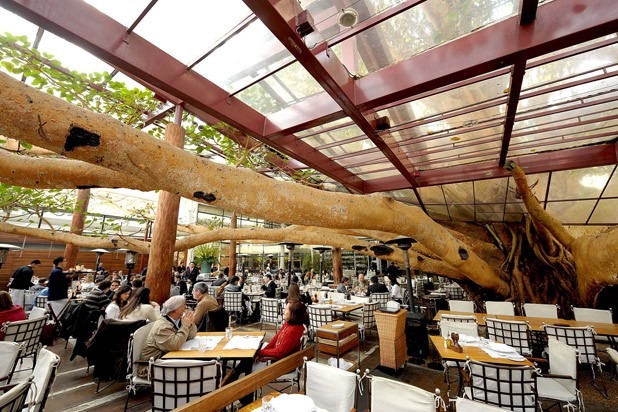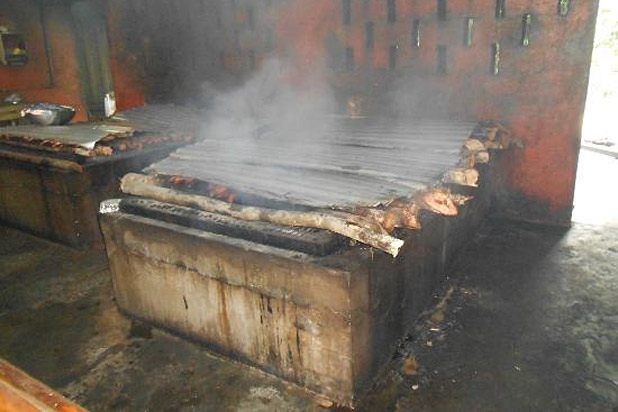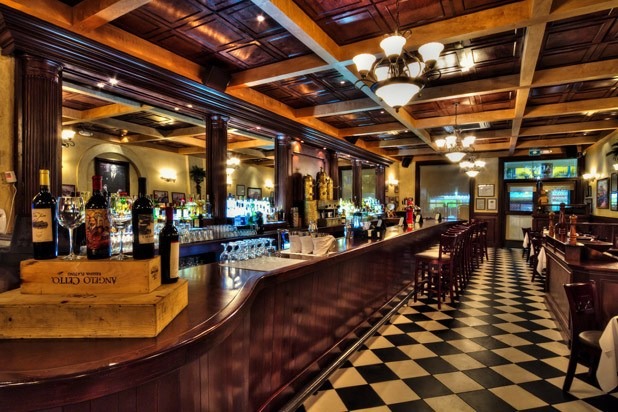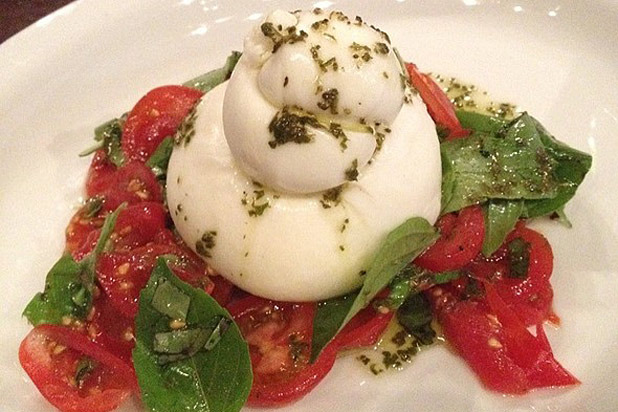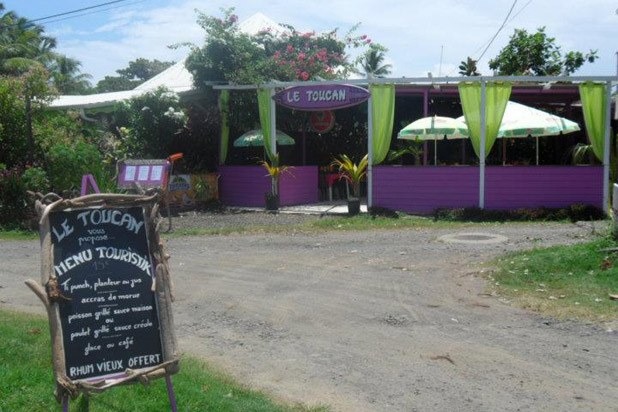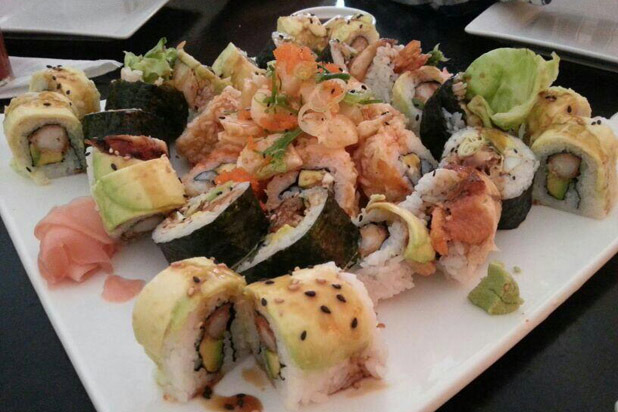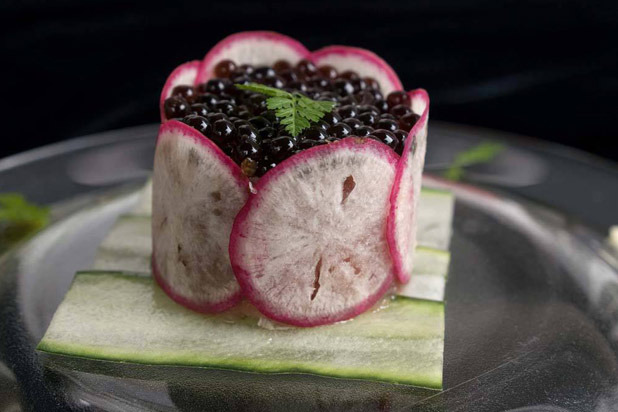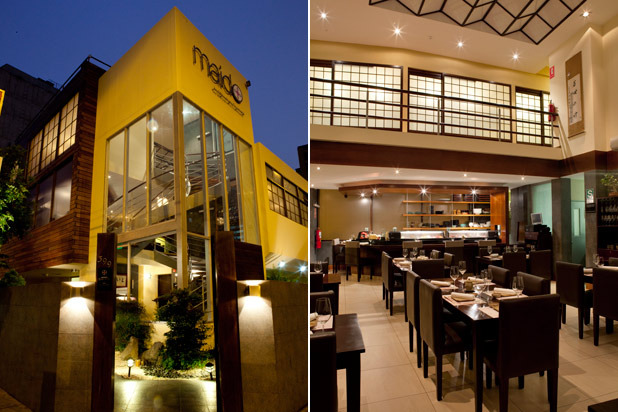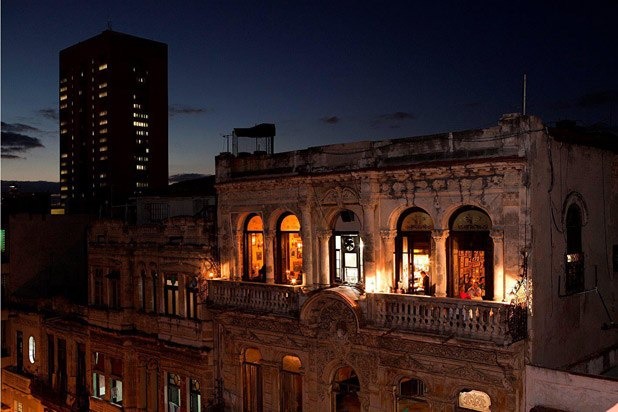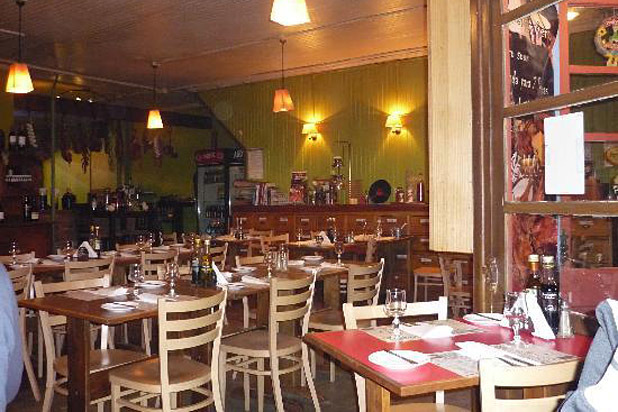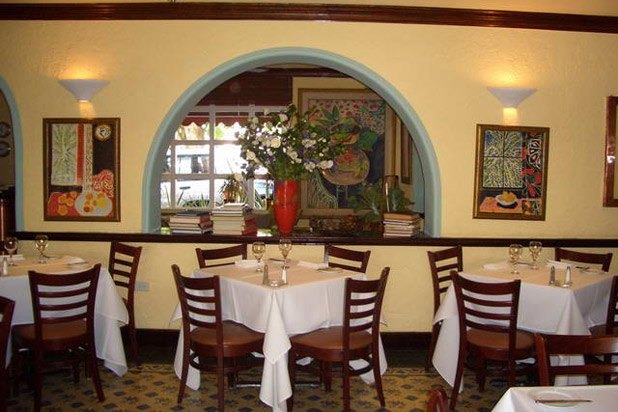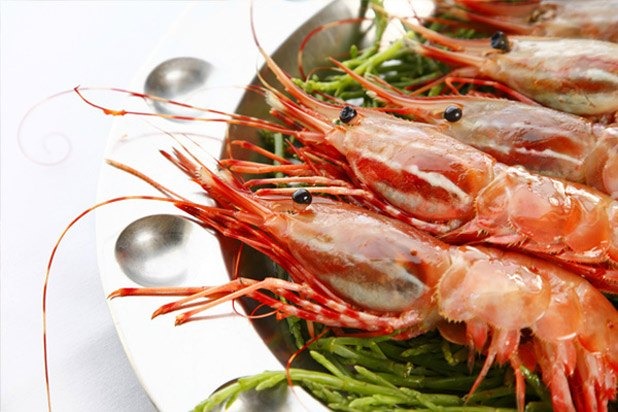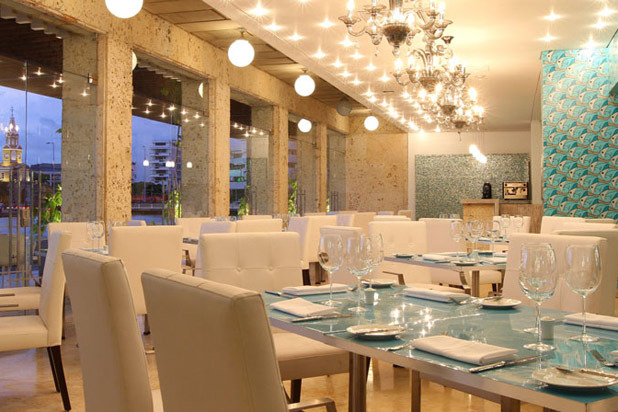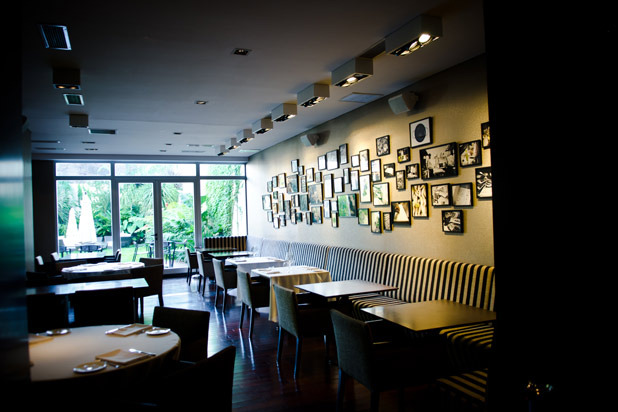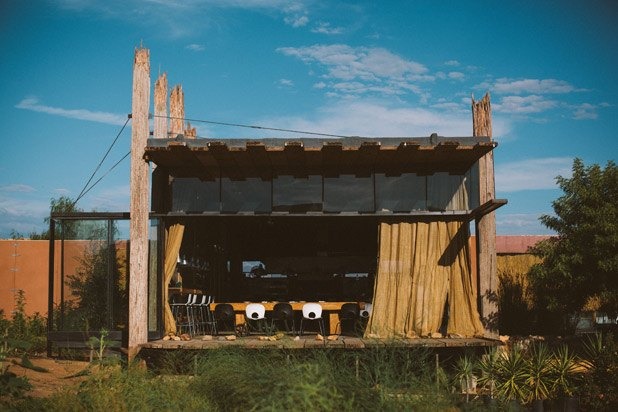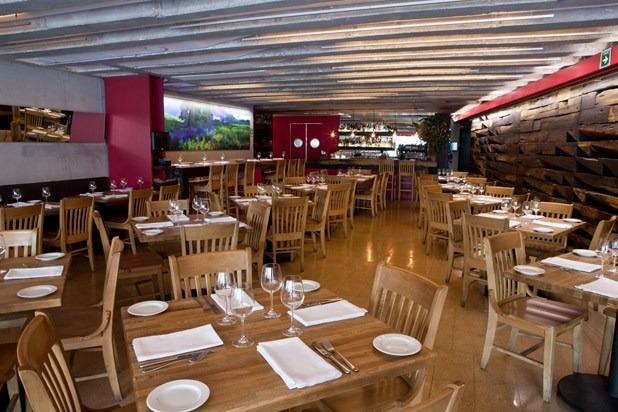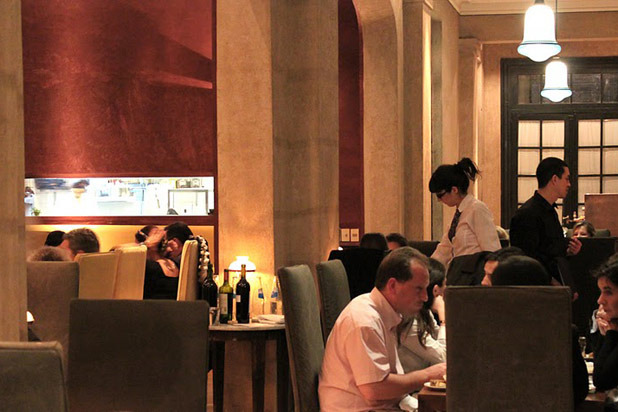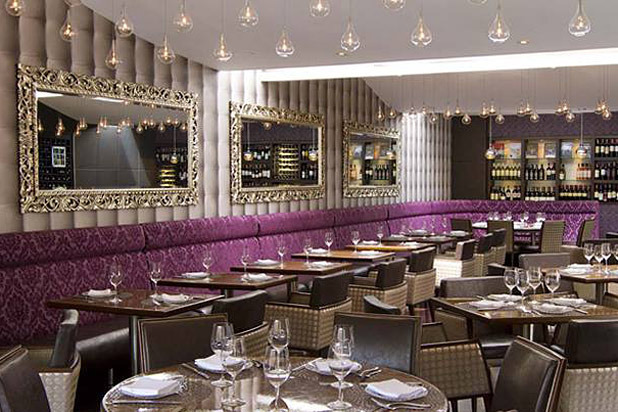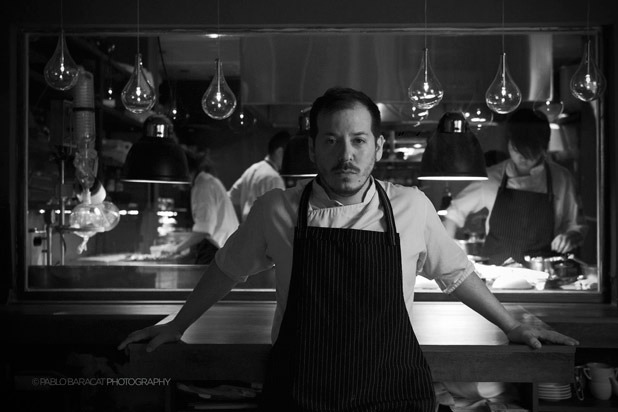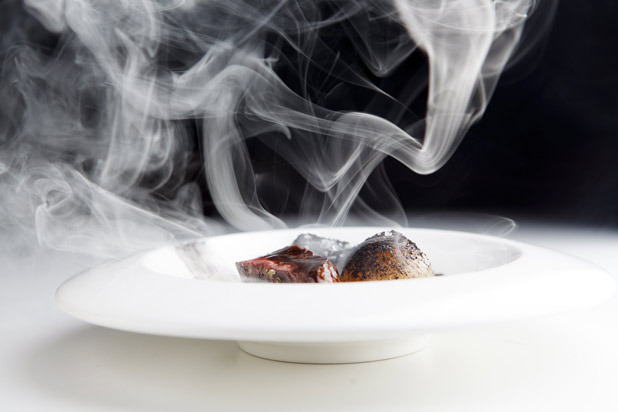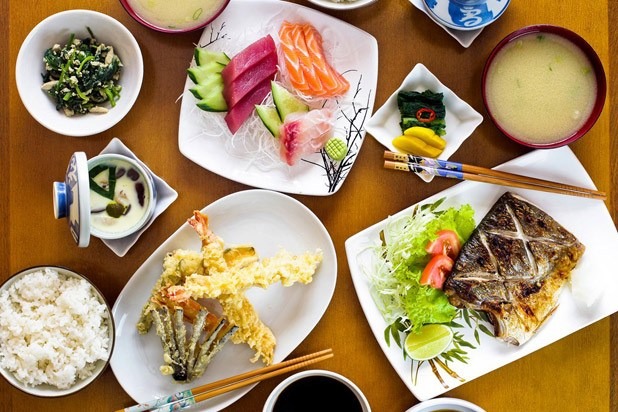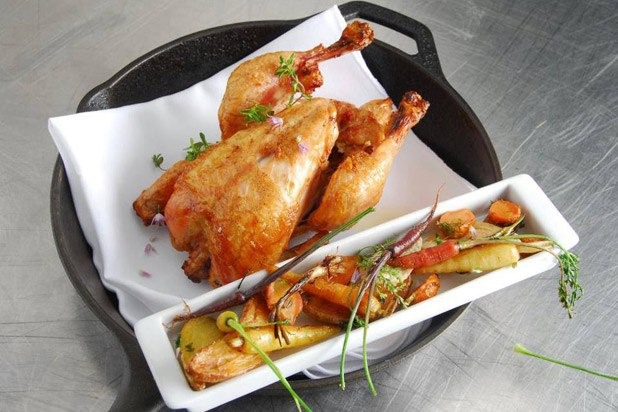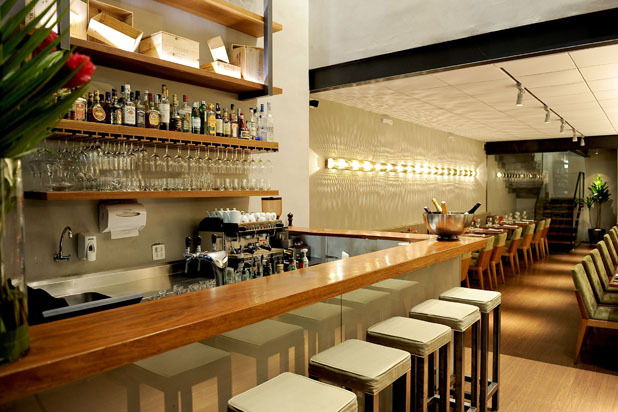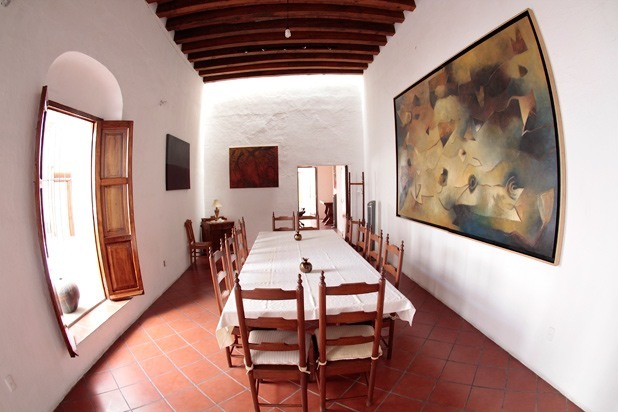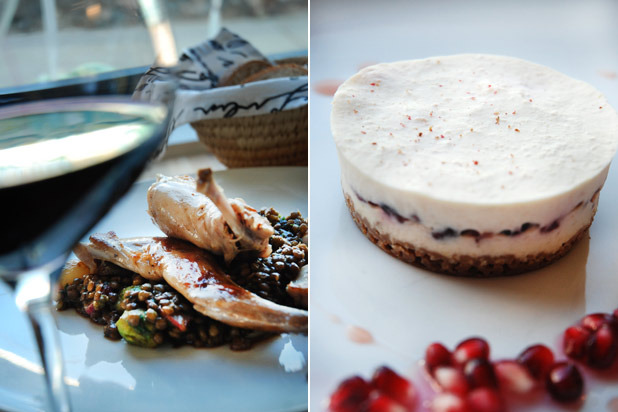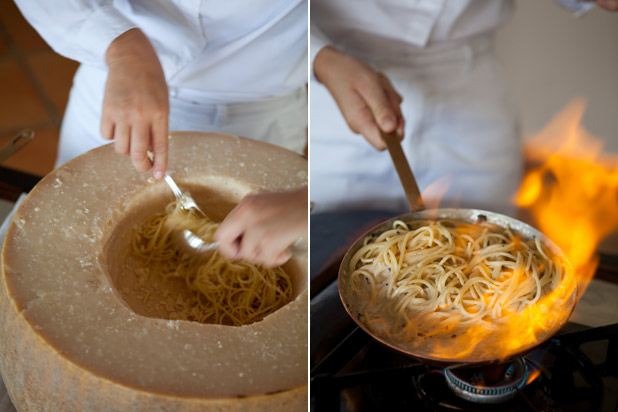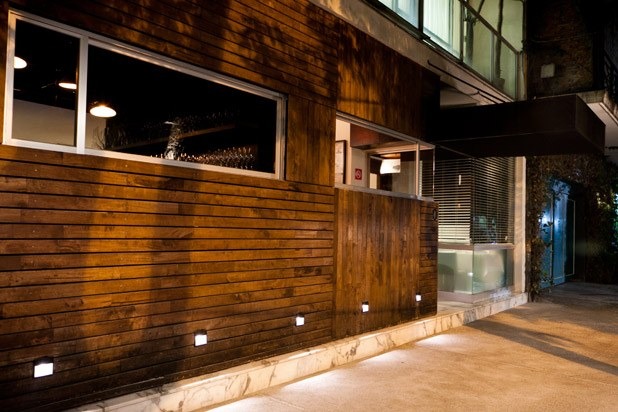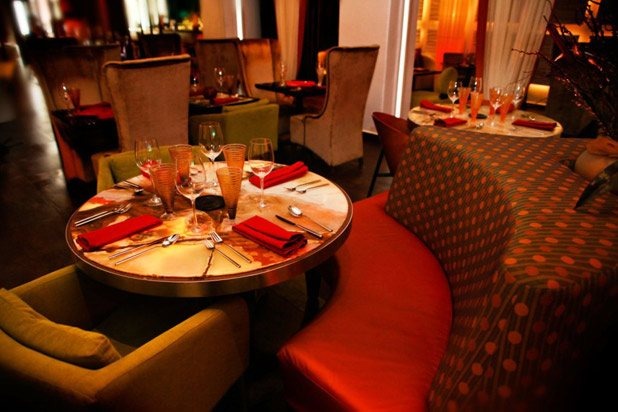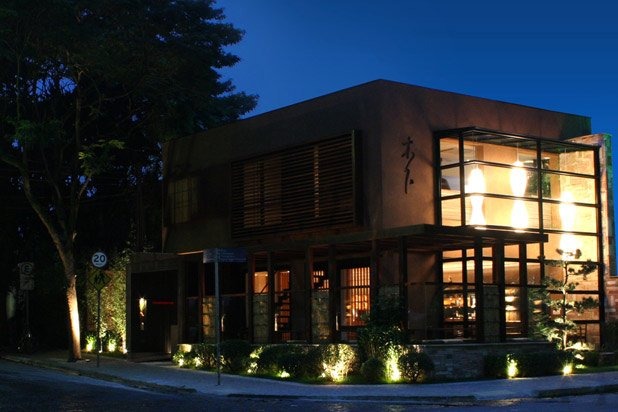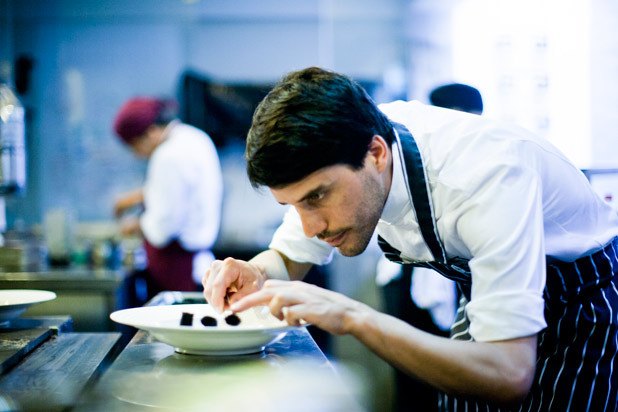101 Best Restaurants In Latin America And The Caribbean (Slideshow)
Opened in 2001, this classic Brazilian restaurant is known for its steak and its beautiful dining area built around a massive fig tree, more than 25 feet in diameter and 130 years old. The menu specializes in beef, as well as other proteins such as suckling pig, and Rubaiyat's meat is sourced from the restaurants own farm. The kitchen focuses on ancient cooking techniques and uses old cooking tools such as steel pans and earthenware ovens. Besides Rubaiyat's famous meat, diners can enjoy seafood dishes such as grilled sea bream, and seafood stew with octopus, scallops, shrimp, squid, and fish. A Figueira Rubaiyat is one of six restaurants in the Rubaiyat group, which has outposts in Peru and Spain, as well as other restaurants in São Paulo.
100. Banana Tree Grille (St. Thomas)
Overlooking the world-famous Charlotte Amalie Harbor, Banana Tree Grille invites guests to be "romanced by stunning sunsets" while dining on top-notch seafood. Menu items may include moist and flaky swordfish served atop a bed of risotto, corn, and sun-dried tomatoes, or Moroccan-spiced ahi tuna served with almond and forbidden rice pilaf and Burgundy reduction. Guests can sip a mango Bellini while enjoying a view of the water that can't be beat.
99. Femmes du Chalet (Port of Spain, Trinidad and Tobago)
Located on the water and traditionally a place for dock workers to grab a bite to eat before a long day of work, Femmes du Chalet, better known as The Breakfast Shed, is now a place where anyone to stop in for something quick to eat. Serving local Trini food, the restaurant is said to be one of the best places to experience the cuisine. It offers everything from pawpaw fruit smoothies to slices of yams, plantains, and breadfruit to fish stewed in tomatoes and served with coo-coo (a cornmeal paste) and callaloo (a steamed leaf vegetable).
97. Red Cabbage Café (Puerto Vallarta, Mexico)
Celebrating its 20th anniversary in 2014, this small café might be hard to find, but it's definitely worth the search. The bohemian dining room of Red Cabbage Café is a colorful one, with brightly painted walls covered with photographs, paintings, posters, and magazine clippings about cultural icons of Mexico, including Frida Kahlo, who even has a special menu dedicated to her, replicating dishes she and husband Diego Rivera used to prepare for guests. That menu includes things like cream of peanut soup (which, according to Red Cabbage Café, was the opening course at Kahlo and Rivera's Christmas dinners); mole poblano, made with 25 different ingredients and served over chicken breast with rice and beans; homemade flan; and of course a shot or two of tequila or a margarita. Other than the special Kahlo menu, Red Cabbage Café offers a versatile mix of dishes from different regions of Mexico, including tortilla soup, stuffed chile peppers, and tacos, all made from scratch and in authentic style. The restaurant also offers cooking classes.
98. Empanadas Las Hermanas (Santiago, Chile)
Hidden in a residential neighborhood near Los Dominicos and operating out of a home with just a single table and four chairs sitting in its driveway for guests to use, Empanada Les Hermanas uses old, but good, family recipes to create homemade pies, dough, fillings, and more. Though it's not the easiest restaurant to find in Chile, it's certainly worth the pursuit if you're searching for a memorable empanada. What distinguishes this empanada from others is its crust, which is thinner and flakier than most, as well as the queso fresco, which helps to create a lighter-than-average empanada. For fillings, diners can choose from pino (beef with onions, raisins, olives, and egg), cheese, ham and cheese, shrimp and cheese, chicken and cheese, and even oyster.
96. Bodega y Granja Narbona (Carmelo, Uruguay)
On the grounds of an estancia (agricultural estate) dating from 1732, the dining room here is warm and rustic, with rough brick walls, wood slat floors, communal farmhouse tables, and shelves lined with bottles and jars full of the bounty of the farm and winery. The fixed-price dinner served uses a lot of that bounty, beginning with big platters of the farm's Parmigiano-like cheese and assorted cold meats. Like Argentina, Uruguay has a large population of Italian origin, and a range of old-style pastas served family-style comes next: fettuccine with Bolognese sauce, green ravioli filled with chopped spinach and herbs and tossed in fresh tomato sauce, and sorrentinos (oversize round ravioli) filled with ham and ricotta and glazed with a cream-and-tomato salsa rosa. Desserts include seasonal fruit tarts, homemade ice creams, and dulce de leche with preserved fruits right off the shelves, and the finca's own wines are poured generously. (On special order, wood-oven-roasted chicken or beef can be added to the menu.)
95. Scotchies (Montego Bay, Jamaica)
Every Jamaican has a favorite jerk shack, a preferred source of the allspice-and-chile-marinated grilled chicken or pork (sometimes fish) that has become Jamaica's most popular culinary export. Tradition has it that jerk was invented on the beach at Boston Bay, near Port Antonio on the island's northeastern coast, but arguably its most celebrated purveyor today is this roadside jerk emporium about 130 miles to the northwest, in Montego Bay (there are newer offshoots in Kingston and outside Ocho Rios). The place couldn't be simpler: Some open-sided structures with palm-frond roofs (one of which holds a small bar with plenty of rum to be had), rough-hewn wooden tables and chairs (including some barrel chairs), and windows in the side of a building where customers order and pick up their food — assertively but not aggressively spiced chicken, pork, or fish cooked on open-air grills over allspice (or pimento, as it's called in Jamaica) wood, served with such side dishes as rice and peas (meaning field peas), roast yams, roast breadfruit, and "festival" — sweet fried cornmeal dumplings, a bit like hush puppies turned into a confection. This isn't sophisticated food, but it's honest and filling and tastes really good, and the setting is pure Jamaica.
94. The Bottle Restaurant (Georgetown, Guyana)
You don't make it to Georgetown, Guyana, without a little bit of the intrepid spirit of an adventure traveler. Sure, there are reasons to visit the country — Kaieteur Falls, turtle trekking at Shell Beach, the Iwokrama Research Centre — but if you've found yourself here, you're most likely to be either visiting someone you know or making the trip either to or from Suriname or Brazil. In any of these cases, at some point you're going to be looking for something beyond the Guyanese classic pepperpot and even its exceptional roti, and at that point you're going to want to visit Cara Lodge, a colonial-styled building in the heart of Georgetown built in the 1840s that has seen the likes of kings, princes, presidents, and rock stars. There you'll find the Bottle Restaurant, which those who know the country will likely argue is the best restaurant in Guyana. Past the mango tree in the center of the courtyard, the ground floor restaurant is decorated with hundreds of Dutch bottles and Portuguese tiles. It's a clean, calming white-tablecloth restaurant that serves many of the traditional dishes of Guyana, including ginger soup, grilled snapper, and baked lamb.
93. Restaurant at Ponta Dos Ganchos (Governador Celso Ramos, Brazil)
Some diners grow tired of a menu that never changes, so the restaurant at Brazil's Ponta Dos Ganchos makes sure that its guests are never bored, by "astonishing" them with a menu that changes daily. That menu incorporates local fish, prawns, oysters, and mussels freshly caught on the island, as well as ingredients grown in the restaurant's organic kitchen garden. And no wine lover will ever be bored here, with more than 250 choices, including South African, French, Portuguese, Australian, New Zealand, Italian, German, Spanish, Argentinean, Chilean, Brazilian, and North American vintages. Because everything at Ponta Dos Ganchos is about that "wow" factor, guests are welcome to enjoy a meal from Ponta Dos Ganchos wherever they please: on the island, on the beach, or in the restaurant.
92. Caesar’s Restaurant at Hotel Caesar’s (Tijuana, Mexico)
While its location in a seedy section of Tijuana may seem off-putting to some, it was at Caesar's Restaurant on Avenida Revolución that the Caesar salad was invented, by immigrant Italian chef Caesar Cardini, in the 1920s, and the place is still very much worth visiting today. The décor is old-school — dark wood paneling, ancient espresso machines at the bar, photos of a bygone era — but the restaurant (not the hotel) was taken over in 2012 by Javier Plascencia, the innovative chef-restaurateur who has worked to revitalize Tijuana's dining scene. He has brought first-rate Mexican and continental cuisine here — including you-know-what, tossed tableside.
91. Garam Masala (Providenciales, Turks & Caicos)
Located in the popular shopping and entertainment plaza The Regent Village, Garam Masala stands out among the many beachside dining restaurants by serving traditional Indian fare from the Moghlai and Punjabi regions. If you're looking to switch things up from the standard "catch of the day" order while in the Caribbean, try browsing through Garam Masala's extensive list of Indian curries and kebabs. Menu highlights include the aromatic Rogan Josh mutton curry, with mutton cooked in a yogurt-based sauce with herbs and light spices, and classics such as seekh kebabs, made with delicately spiced minced meat that's rolled into the shape of a sausage and cooked in the a tandoori oven. The restaurant also offers wine, beer, and house cocktails.
90. Bar do Mineiro (Rio de Janeiro)
Ask anyone in Brazil, and they'll most likely tell you that Minas Gerais is the place for the best food in the country. If you're not going to be in Minas, one of the next best things is to stop by the Bar do Mineiro toward the top of the Santa Teresa hill in the center of Rio de Janeiro, an area famous for its winding, narrow streets. A restaurant as well as a bar, the place serves generous portions of feijão tropeiro (beans with sausage, served over rice), an assortment of pasteis (savory pastries), frango com quiabo (stewed chicken with okra), and of course feijoada.
89. Emilia Romagna (Bogotá, Colombia)
Before opening his own restaurant, chef and owner Daniel Castaño attended the French Culinary Institute in New York and worked for Mario Batali at Lupa and Babbo. Emilia Romagna quickly became a popular dining destination in Colombia's capital and was named best new restaurant by the magazine La Barra in 2009. The cozy restaurant offers a menu of authentic Italian cuisine, with a wide selection of dishes perfect for sharing. Diners can choose from different cheeses, salads, appetizers, and larger courses like pasta or fish. Notable dishes include an appetizer of fried chickpeas with red onion, lemon, and parsley; classic pasta dishes like fettuccine carbonara with ham, egg, and Parmigiano; and mains including octopus with cannellini bean ragù. Emilia Romagna also offers an extensive wine list with a selection of bottles from Italy, Argentina, Chile, Spain, and California.
88. Le Toucan (Le Vauclin, Martinique)
Beachside dining and French-Creole cuisine are on offer at Le Toucan. For tourists preparing for a day of watersports and enjoying a day at the beach with the family, the simple, no-fuss restaurant offers a choice of prix fixe menus including an "Express" menu and a "Tourist menu," as well as à la carte options. Think Creole salad, grilled lobster, locally caught red snapper, and homemade desserts.
87. Fugu (Caracas, Venezuela)
Opened in 1994 under the name Taiko, this traditional Japanese restaurant changed names in 2012. Despite the revamp of the restaurant, the cuisine remains similar — if not even more authentic — as the Japanese owner, Tetsuro Nakada, also brought in a native Japanese chef, Satoru Kimura. Not only does chef Kimura master the skills of sushi, but he's also certified to cook the lethal (if wrongly prepared) puffer fish for which the place is named. The menu offers a selection of classic Japanese fare like sushi, sashimi, tempura, and teriyaki, including items such as soft-shell crab tempura, beef skewers with tonkatsu sauce, and the "Mother and Son Roll" with salmon, avocado, and cream cheese, and salmon roe on top.
86. Silvestre (Valle de Guadalupe, Mexico)
An outdoor grill and picnic tables under a canopy hung with ceiling fans are all that chef Benito Molina, of Ensenada's Manzanilla (see number 43) needs to satisfy touring wine lovers (and indigenous winemakers) in the Valle de Guadalupe, Mexico's premier wine country, inland from the coast. Its name means "wild," and Silvestre — open only on weekends, and only from late spring to early autumn — indeed has an attractively unstructured, out-in-the-countryside feeling about it. The menu is fixed-price, including six courses of locally sourced foodstuffs — perfect salads, grilled organic vegetables, lightly smoky grilled oysters, great seafood from all along the Baja littoral (swordfish and tuna are regulars), maybe herb-strewn lamb or Sonoran rib-eye steak with grilled scallions and tortillas, and Baja cheeses. It all tastes even better than it probably would in an indoor restaurant; that expanse of vineyard that begins just a few feet away adds real flavor.
85. Aconchego Carioca (Rio de Janeiro)
Located in the northern outskirts of Rio de Janeiro's city center, Aconchego Carioca is a popular neighborhood eatery and bar, offering traditional Brazilian fare with a twist, and a wide selection of beer. With a seedy past of low-income housing and prostitution, the Praça da Bandeira neighborhood might still not be one of Rio's finest, but is rapidly changing, and the weekend crowds standing in line for a table here are a sign clear sign of the growing gentrification. The fare includes bolinho de feijoada, mini "feijoada cakes," a play on the traditional Brazilian dish feijoada, a hearty mix of beans and pork. In Aconchego Carioca's version, black beans and collard greens are battered and fried into small balls and eaten with torresmo (cracklings). For a uniquely Brazilian dessert, try the palitos de queijo coalho com goiabada cremosa — sticks of lightly battered and fried cheese served along with a guava jam (the dish looks suspiciously like french fries and ketchup). Besides the hearty food, diners can choose from an extensive beer list of around 250 beers, including both imported and local specialties.
84. Restaurante Zafferano at Mantra Resort, Spa, & Casino (Punta del Este, Uruguay)
Perched on a hill above La Barra's Manantiales Beach, Restaurante Zafferano overlooks the 100-room resort's serene pool and lush tropical gardens. Diners at Zafferano can choose to sit inside in the sleek dining room, or at a table outside on the pool deck, enjoying the fusion cuisine with contemporary Mediterranean and Asian flavors. Dishes include cold almond and garlic soup and sliced duck with caramelized apple and sweet potato.
83. Sukalde (Santiago, Chile)
The décor at Mexican chef Matías Palomo's Sukalde is simple — white walls, high ceilings, and dark wood floors — but the food here is not. Complex and creative, Palomo, who worked the kitchens at Arzak, Daniel and elBulli, has crafted his own interpretations of international cuisine with Latin flair. Examples abound on the tasting menu, which recently included Patagonian oysters with potatoes and fennel, pork with black quinoa and merkén bisque; and textured chocolate and egg pudding. A must-try pre- or post-dinner is one of the restaurant's seven pucker-y but sweet pisco sours, including versions with merkén and calafate (a Patagonian liquor). ¡Salud!
82. Kaa (São Paulo)
Even the most hardened world travelers, the most citified of city dwellers will likely admit to you that the first time they landed in São Paulo, the vastness of the city was overwhelming. With an ever bigger population than New York City, its concrete jungle seems to stretch on even farther into the horizon. With that kind of density, it should perhaps not surprise that one of São Paulo's most buzzed about restaurants over the past few years is Kaa (the Tupi word for leaf, grass, and brushwood), which offers the refuge of a secret garden — a wall about 26 feet high and more than 200 feet long featuring more than 7,000 plants native to Brazil's Atlantic forest (the restaurant was designed by architect Arthur Casas). But it's not just the space that impresses at Kaa — there's Italian food by chef Paulo Barros to match, and that's saying something for a city with no dearth of good Italian restaurants (São Paulo is said to have the second highest population of people with Italian ancestry in the world). Bauletti stuffed with guinea hen, ricotta, and truffled mushroom sauce; panciotti stuffed with braised beef brasato in creamy lentil sauce; veal shank confit; and at least five different risotto preparations... delicioso!
81. The Cliff (Barbados)
The waves crash against the rocks, the water stretches out into the distance to meet the night sky, and all around you on the outdoor dining patio candles flicker on the tables and warm light shines down from lanterns above them. Maybe you walked, or arrived by car. Maybe you arrived by yacht (it's situated so that you can, and the restaurant even bears a resemblance to the bow of a ship). However you arrived, if you're at The Cliff in Barbados, you've found yourself at one of the most beautiful and dramatic restaurants in the Caribbean, and you're in for a treat. Liverpool-born chef Paul Owens' menu changes frequently, but you can count on char-grilled meats and seafood including mahimahi and swordfish, and spellbinding dishes like Caribbean shrimp in Thai green curry coconut sauce with coriander rice, foie gras and chicken liver parfait, savory snails in puff pastry with chive cream sauce, and even a spicy Caesar salad with chorizo.
80. Maido (Lima, Peru)
After years spent toiling in sushi kitchens in Japan, Peruvian-born chef Mitsuharu Tsumura has created a masterpiece at Maido, his Nikkei restaurant in the seaside district of Miraflores. Nikkei is a century-old fusion of Japanese food with Peruvian characteristics, which began in Lima and draws inspiration from the decades of Japanese immigration to Peru. Maido, which is a greeting in Japanese, welcomes diners to its sushi counter seats and tables with an ever-changing omakase menu of nigris, ceviche, and tiraditos, the contents of which are based on the daily catch and the chef's imagination.
79. Da Conch Shack (Providenciales, Turks & Caicos)
Chef Mark Clayton is onto something at the shabby, open-air, and legendary Da Conch Shack. Just off Blue Hills Road and adjacent to a parking lot replete with an aging boat full of conch shells, Da Conch Shack is the type of beach bar that beach bums yearn for — fresh, tasty seafood and potent rum-laced drinks with a punch. While the menu includes options like shrimp, fish, and jerk chicken, it's the namesake conch that keeps folks coming back year after year. No matter how you want your conch — as cracked conch dusted with flour and fried, as a conch salad (conch ceviche with tomatoes, green peppers, onions, and lime juice), in a curried conch chowder, or as crispy conch fritters — be sure to pair it with Johnny Fries (Turks & Caicos salted french fries drizzled with black bean and pepper gravy) or island staple rice and peas and a pitcher of rum punch. Don't forget to save room for the rum cake garnished with rum raisins.
78. La Marea Restaurant (Playa del Carmen, Mexico)
La Marea Restaurant is not a typical surf-and-turf establishment. Tucked within the Viceroy Riviera Maya in the small village of Playa Xcalacoco, just outside Playa del Carmen, the beachfront resort restaurant is a refuge of fine dining. The restaurant is open for dinner only, and Mexican chef Jetzabel Rojas Barragán prepares contemporary interpretations of Mexican cuisine with Mediterranean influences — for instance plantain risotto with crispy Ramonetti cheese, cinnamon, and poached egg; cocoa-crusted Sonora rib-eye with wild mushrooms, roasted Cambray onions, and pasilla chile sauce; and Puerto Morelos poached lobster tail and risotto with asparagus risotto, sweet potato chips, and vanilla butter.
77. La Guarida (Havana, Cuba)
Its appearance in the Cuban film Fresa y Chocolate isn't the only reason that discerning diners head to this hidden gem run by husband-and-wife duo Enrique and Odeisys Nuñez in central Havana. This paladar (a small, family-run restaurant typically located inside a home that gained legal status in Cuba in the early 1990s) is tucked up three flights of rickety stairs at the top of a dilapidated turn-of-the 20th-century residential edifice at 418 Concordia. La Guarida's whimsical setting, which stretches through three small rooms, is adorned with autographed celebrity photos. Start off with the eggplant caviar before moving on to sea bass in coconut reduction, and chicken with honey and lemon sauce. Reservations for lunch and dinner (two seating times) are essential.
76. Maras (Lima, Peru)
The culinary tour de force that is Maras is an education in modern Peruvian cuisine. The restaurant's name is derived from Peruvian legend, and is a nod to the place where the country's famed pink-hued salt is produced. Try to book the 10-seat chef's table, where diners can interact with the chef, Rafael Piqueras. The outdoor terrace lit with kerosene lamps and candles is a nice backup spot to sample Piqueras' traditional yet forward-looking Peruvian fare. The chef, who worked in famed restaurants such as Antica Osteria del Teatro, El Cellar de Can Roca, and the now-closed elBulli, prepares an exceptional tasting menu. Standout dishes include a corn tart filled with oxtail ragù, foie gras with pisco aromas and roasted mango, and tuna tiradito with chile sauce and glazed sweet potato.
75. Paraje Arévalo (Buenos Aires, Argentina)
Artful globe-trotting gastronomy that is an exceptional feast for the senses can be found at Paraje Arévalo. It's one of the best of the numerous restaurants in the neighborhood dubbed "Hollywood Palermo" for the number of radio and television producers who have put down roots here. Chef couple Estefanía di Benedetto and Matias Kyriazis (who also helm the more causal Local and pop-up concepts Casa Arévalo and TC Gourmet) prepare ever-changing six- and eight-course degustation menus, with each plated course reminiscent of minimalist art installations. Each avant-garde dish is carefully constructed with two or three ingredients meticulously arranged in a smattering of bright, bold, and innovative patterns and presentations. The dining room's simple décor — pale walls, crisp white linen table cloths, and checker-tiled floors populated with nostalgic props like an antique refrigerator and bicycle — gives just enough character to the space without overpowering the main event: the gorgeous and delightful international cuisine. Recent offerings have included chicken liver parfait with pickled apples, curried almonds, and croutons, and salmon cooked in beet juice at 131 degrees Fahrenheit.
74. Osaka (Lima, Peru)
Since opening its doors in 2002 in central Lima, Osaka has expanded to six outposts: two in Lima, two in Buenos Aires, one in the W Hotel in Santiago, Chile, and one in São Paulo. While the décor and menu differ slightly at each locale, the emphasis on modern and innovative Nikkei dining (a century-old fusion of Japanese food with Peruvian characteristics, which began in Lima and draws inspiration from the decades of Japanese immigration to Peru) is consistently stellar. The restaurant features a massive sushi bar in one corner and two tatami rooms. Tuck into ceviches, tiraditos (raw fish and spicy sauce similar to carpaccio), and sushi rolls and you won't be disappointed.
73. Pasta e Vino (Valparaiso, Chile)
Pasta e Vino is perhaps the best example of this port city's culinary transformation a decade ago. Owners Paolo Ercole (who hails from Italy) and Verónica Alfageme (a Chilean raised in the Canary Islands) serve dozens of straightforward but delicious pastas and gnocchi in a former corner store, revitalized into an intimate 12-table dining room with high ceilings and exposed brick. Appetizers like duck salad with sun-dried kiwi and toasted hazelnuts are preludes to mains like corn gnocchi with shredded beef; fettuccine with lemon, smoked ham, and white wine; and broad bean ravioli in orange juice reduction sauce with Ecuadorian shrimp. Dessert is equally captivating, with offerings like quince crumble with caramel sauce and an artisanal ice cream tasting.
72. Los Danzantes (Oaxaca, Mexico)
Yes, it's touristy, but Los Danzantes delivers a supreme sampling of Oaxaca's famous moles and mezcal. Los Danzantes ("The Dancers") is named for carvings of dancing figures on the ruins of nearby Monte Albán. Set in the courtyard of a renovated three-story colonial building, the 80-seat open-air dining room with adobe walls and a shimmering pool is often packed with tourists dining on fondue de huitlacoche, a corn fungus and cheese fondue with serrano pepper served in a rustic bread bowl; breaded chicken breast stuffed with goat cheese and porcini mushrooms with chipotle cream; and shredded turkey with red mole and chayote. The goat cheese flan with figs, honey, and chocolate sauce, and the empanada with quince, cream cheese, and a red wine reduction are sweet endings to an iconic and memorable Mexican meal.
71. 1919 Restaurant (San Juan, Puerto Rico)
Named for the year its home (the recently renovated 305-room Spanish Revivalist Condado Vanderbilt Hotel) opened, 1919 Restaurant and its executive chef, Juan José Cuevas, have quickly garnered accolades for forward thinking, contemporary cuisine. The dishes are crafted with organic, artisanal, locally sourced ingredients. Cuevas has done stints in the world's most renowned kitchens, including the three-Michelin-starred Akelare in San Sebastián, the now-shuttered three-Michelin-starred El Racó de can Fabes in Sant Celoni, and the now-closed Alain Ducasse at the Essex House in New York City. The four-course dinner menu includes selections like roasted octopus with organic grains, clams, beans, cucumber, preserved lemon, and herb oil; acquerello risotto with zucchini, Parmigiano, bacon, mozzarella, and coffee; wild king salmon with zucchini, ricotta, basil, olives, guindilla chiles, tomato confit, and pimentón sauce (made from smoky Spanish paprika); and Chocolate Decadence (chocolate tres leches, 65 percent chocolate mousse, brownie with granola, and chile-infused chocolate ice cream).
70. Muelle Tres (Ensenada, Mexico)
Owner David Martinez and chef Andoney Garcia run this tiny, super-casual seafood place, open Tuesday through Sunday from 1 p.m. to 7 p.m. only, showcasing absolutely fresh fish and shellfish harvested locally. Come here for crema de almeja (a Baja take on clam chowder), local oysters, sashimi or ceviche of whatever's fresh and good, fried calamari, steamed clams, giant shrimp with garlic sauce, or seafood-laden rice or pasta. Simple white wine and cold beer flow freely.
69. Parador La Huella (José Ignacio, Uruguay)
Don't be put off by the shabby-chic appearance of this beachfront thatched-roof retreat set amid the dunes of Playa Brava in southeast Uruguay. The aptly named Parador La Huella ("the footprint") and chef Alejandro Morales have made an indelible mark on Uruguay's culinary scene and put the once sleepy fishing town on the map. There's no pretentiousness here — just simply prepared and presented cuisine from Latin America and beyond, like sushi; flame-grilled whole corvina with butter, olive oil, and garlic; and plancha-style shrimp. And you must top off your meal with the molten dulce de leche cake. The freshly baked bread is made with a recipe from San Francisco's Tartine Bakery and the restaurant sources its produce from a nearby organic farm. No matter what you order, it all goes well with clericó (a fruit punch drink similar to sangria).
68. Birriería Las 9 Esquinas (Guadalajara, Mexico)
Tucked in the charming working class neighborhood of Las Nueve Esquinas ("the nine corners," named for the area's numerous intersecting streets), Birriería Las 9 Esquinas is the top spot to sample birria (a spicy Mexican goat stew that originated here in the state of Jalisco). Proprietor Don Federico greets diners and seats them in the blue-and-yellow-tiled, colonial-style dining room while Doña Lupita prepares the restaurant's namesake dish. Complimentary cebollitas (baby onions) and tortilla chips are brought to the table while live music entertains guests as they wait for the birria to be served. Here, the birria consists of goat with mirasol, ancho, and pasilla chiles cooked overnight over a low fire and served with a consommé (a clear broth). It's best eaten by first scooping the meat up with a tortilla chip and then dipping it into the broth — delicioso!
67. El Asador Patagónico (Puerto Natales, Chile)
Housed in a space that for 60 years was the village apothecary, El Asador Patagónico has kept some of the space's old furniture, creating a nostalgic atmosphere. It's known for fresh salads made with ingredients from the gardens in the area, lamb that is roasted over a fire pit and seasoned simply with salt, and a delicious pisco sour.
66. Café de Tacuba (Mexico City)
This historic Mexico City institution, founded in 1912, is big, bright, and bustling, from the entrance, with its massive mural depicting chocolate in various contexts (being enjoyed by a nobleman, being mixed into mole in a convent kitchen), which overlooks the pastry counter, to the back dining rooms with their ornate mirrors, wrought-iron railings, and Moorish-style lights. The menu is an anthology of Mexican specialties with other homey specialties added. Standouts include the mole poblano enchiladas, the chicken tacos with guacamole, the chuchulocos (taquitos) in hot sauce, the barbecued pork steak, the fried calf's brains, the beef filet with chilaquiles (cut-up tortillas in a chile-based sauce), and the assorted house-made Mexican pastries.
65. Flora's Field Kitchen (San José del Cabo, Mexico)
Located down a rutted, dirt road in the center of Flora Farm, a 10-acre organic farm in the foothills of the Sierra de la Laguna Mountains, Flora's Field Kitchen offers the ultimate in farm-to-table dining. All ingredients used come from the farm owned by Gloria and Patrick Greene; breads are made from a wood oven and the free-range meat comes from their nearby 150-acre ranch. At night and on Sundays, the wood oven is used to craft 12-inch Neapolitan-style pizzas with toppings such as house-made lemon ricotta and thyme. The seasonally changing menu, which ranked number eight on The Daily Meal's 25 Best Farmstead Restaurant Experiences, includes family-friendly comfort foods served family-style or à la carte like double-cut pork chop and oven-roasted half chicken. Farm walks are offered pre-meal.
64. Café Matisse (Nassau, Bahamas)
In the Bahamas, it's difficult to find a charming restaurant with exceptional fare where the clientele are not decked out in T-shirts and sandals, but Café Matisse comes to the rescue. The café is a welcome respite for island visitors looking for a sophisticated meal, as diners are required to wear "proper dress" to dine here. The quaint restaurant — set in a centuries-old colonial mansion where reprints of Matisse's work deck the walls — is run by a husband-and-wife duo. The menu features simple Italian fare that is best enjoyed alfresco on the café's courtyard veranda. The couple blends their Bahamian and Italian cultures brilliantly with seasonally changing appetizers like cured beef with Parmesan ice cream and warm shellfish salad with guacamole and citrus sauce, and mains like sliced duck breast marinated in orange and ginger with parsnip flan and T-bone steak with asparagus, arugula, Parmesan shavings, and grilled tomatoes. Save room for the desserts, which include avocado mousse with raspberry sauce and green apple crumble with Calvados sauce and cinnamon ice cream.
63. Sujinho (São Paulo)
Sometimes character, legend, and patina take great food to a new level of restaurant experience. That's the case at Sujinho in São Paulo, a simple old-school churrascaria that has been popular with locals for decades for serving great food at amazingly low prices until the wee hours of the morning (it's still known to Paulistanos of a certain age as the "Bar das Putas" for those who 30 years ago would end their shifts there after an evening selling the pleasures of the flesh). The restaurant (and the area) has cleaned up, but you can still expect character, setting, and on-point espeto misto (mixed grilled meats) and picanha (the classic Brazilian top sirloin cover cut).
62. Chez Bernard (Salvador, Brazil)
Chez Bernard, which celebrated its 50th anniversary in June, was founded by Bernard Goethals and is now headed by chef Laurent Rezette, who carries on the tradition of crafting contemporary French cuisine with a Latin twist. The cozy 40-seat restaurant's wall of windows framed by lush red curtains affords a stunning view of the Bay of All Saints. Diners can select from à la carte options or the four-course lunch tasting menu. Specials include bacalhau, lobster thermidor, steak au poivre, and feijoada (a traditional Brazilian stew).
61. Villa Saverios (Tijuana, Mexico)
A special-occasion place for the well-to-do of Tijuana, owned by the Plascencia family — Tijuana restaurant royalty — with Javier Plascencia (see Misión 19, number 22) in charge of the kitchen, Villa Saverios is a comfortable restaurant, with bare wood floors, mottled walls, white-napped tables, and a glass room divider etched with images of grapes. The open kitchen at end of the room produces what might best be described as sophisticated Mexican-accented continental cuisine based on top-notch fresh ingredients, many of them Baja-sourced. A kind of carpaccio of smoked marlin is dressed in Baja olive oil and garnished with avocado, basil, habanero chiles, and mango vinaigrette; beautiful deep-water Baja shrimp are simply boiled and served on a bed of samphire; oven-roasted short ribs, slow-cooked for eight hours, are nestled on a bed of smashed potatoes enriched with Real del Castillo cheese from Ojos Negros, east of Ensenada. The cooking is first-rate throughout and shows real finesse.
60. La Querencia (Tijuana, Mexico)
Miguel Ángél Guerrero Yaguës, the chef–proprietor of this Tijuana original, may have coined the term "BajaMed" and was certainly one of its earliest practitioners. La Querencia has a hip, contemporary-industrial look, with bare concrete floors, lacquered steel tables, exposed ducts overhead, and low-tech touches like mounted game trophies on the walls, a tropical fish tank at one end of the dining room, and a row of rusty old cooking implements hanging above the divider that separates the open stainless steel kitchen from the dining room. The menu appears on oversize blackboards. Roast duck, lamb chops, and a marinated rib-eye with shallots and Roquefort are available, but the focus is on fresh Baja seafood — scallop or marlin carpaccio, grilled shrimp salad, grilled octopus, a mixed seafood plate with red and white miso sauces and hot chiles. There's also pasta with pesto or romesco sauce, and a range of tacos, tostadas, and burritos employing such uncommon fillings as smoked marlin, giant squid, manta ray, tuna fin stew, and abalone "chorizo" — all of it delicious.
59. Restaurant Emiliano (São Paulo)
The dining room of the handsomely furnished Emiliano boutique hotel is bright and airy, with luminous hardwood floors and a wall of floor-to-ceiling windows giving onto lush flowered hedges. Illuminated by sunlight, it's a warm room with a cool vibe. Here, chef Stefano Impera serves clean-lined, well-crafted food based on organic and sustainably produced ingredients, with a strong Italian accent. Enjoy Impera's pumpkin soup with mascarpone cream, walnuts, and amaretti cookies; his homemade pappardelle with duck confit sauce; medallions of tuna with caponata; or veal cutlet with mushrooms and asparagus — but leave room for one of his desserts, perhaps a chocolate "contrast" with salted caramel and tonka bean ice cream.
58. Andrés Carne de Res (Chia, Colombia)
Andrés Jaramillo has become synonymous with grilled meats in Colombia and beyond, as suggested by the name of his restaurant, Andrés Carne de Res (literally Andrés Beef). What started as a six-table eatery 45 minutes from Bogotá has turned into a behemoth, city-block-long series of dining rooms with a capacity for 3,000 diners. The former visual art student opened the place in 1982 and, in the decades since, has not only honed his grill skills but has amassed a large collection of art that adorns the walls; the restaurant has its own art studio where two dozen artists create the contents of the restaurant, from the tables and chairs to the wall art. Andrés Carne de Res has proven to be successful for its savory arepas, its signature lomo al trapo (salt- and oregano-crusted beef tenderloin wrapped in cotton cloth and charcoal-grilled straight on the embers), and mashed potato-filled tomatoes. Jaramillo has duplicated his recipe for success with Andrés D.C. in Bogotá and the marketplace-style La Plaza de Andrés also in Bogotá.
57. Trellis (St. Martin)
The intimate French bistro housed in the oceanfront La Samanna resort serves contemporary cuisine paired with one of the most extensive wine collections in the Caribbean. Executive chef Gil Dumoulin has curated a menu of modern French cuisine infused with Caribbean spice. Each meal can be expertly paired with one of 12,000 wines from the resort's wine cellar; each label is carefully chosen by sommelier Christian Mirande.
56. Laja (Valle de Guadalupe, Mexico)
When he's not overseeing the cooking at MeroToro in Mexico City (see number 47), Jair Téllez — whose background includes stints at Daniel in New York City, La Folie in San Francisco, and the Four Seasons in Mexico City — is designing daily four- and eight-course fixed-price menus here at his original restaurant, a rustic, laid-back establishment in the Mexican wine country of the Valle de Guadalupe. Téllez was a pioneer of Baja Mediterranean cuisine, and is fanatical about using the freshest and best organic ingredients grown around the place or in other parts of the valley. Because he cooks according to what's best and most seasonal, the particulars can be unpredictable, but his salads are anthologies of freshness, his soups are authoritative (a cream of eggplant with jamón serrano, for instance), his seafood is first-rate (marinated yellowtail with preserved lemon, say), his meat dishes are full of flavor and perfectly cooked (oven-roasted baby lamb raised a mile or so away is a standout), and his desserts, usually based around fruit from neighboring orchards, are bright and refreshing. Téllez makes his own wines, and also serves a fine selection of the valley's best.
55. Oviedo (Buenos Aires, Argentina)
This cosmopolitan Spanish seafood restaurant, with its bustling brasserie atmosphere, serves some of the finest, freshest fish and shellfish in this meat-loving city. Grilled langoustines with cauliflower "couscous" and mustard vinaigrette, mushroom carpaccio with baby squid, salmon ravioli, trout with "black" brown rice, and grilled fish of the day with pumpkin gnocchi and dried tomatoes are typical of the fare here. Apple "panqueques" and quince paste with Argentinean cheese anchor the dessert menu. Oh, and for the unreconstructed, there is of course meat, too — ranging from simple roast Patagonian lamb to wild boar with mushrooms and eggs scrambled with manioc and pancetta.
54. La Bourgogne (Punta del Este, Uruguay)
Nestled among pine forests and sandy beaches in the seaside resort of Punta del Este, La Bourgogne is a piece of Burgundy on the beach. French chef Jean-Paul Bondoux crafts French cuisine seasoned with herbs like thyme, bay leaf, sage, and rosemary, grown on his own farm and served at the garden brasserie he opened in 1981. Try the squash blossoms stuffed with chicken, and the rack of roast lamb with garden-fresh herbs. The boutique adjacent to the restaurant offers the chance to take some goodies like brioches, croissants, and cheeses home.
53. Marea by Rausch (Cartagena, Colombia)
The Rausch brothers, from Criterión in Bogotá, have installed an ornately appointed luxury restaurant, with sea green, sea blue, cream, and gold as the predominant colors, looking out on the harbor in the Cartagena Convention Center — and it has quickly earned a reputation as arguably the best seafood eatery in this seafood-loving city. Their version of the popular local specialty of fried mojarra (a tasty, bony fish found in nearby waters), served with patacones (Columbian fried plantain cakes) and coconut rice, surprised Cartagena diners when they discovered that it had been completely deboned and reassembled, a real treat. Turmeric-flavored seafood rice, crab-enhanced guacamole, and langoustines with chorizo are among the other specialties — and even the steak is first-rate.
52. Moxi (San Miguel de Allende, Mexico)
Condé Nast Traveler recently anointed San Miguel de Allende, a pleasant and colorful artists' and American retirees' community in the state of Guanajuato, northwest of Mexico City, as the top city in the world — leaving such burgs as Barcelona, Paris, Venice, Budapest, Sydney, and Kyoto in the dust. Well, all right. Whatever. But San Miguel is certainly an engaging place, and one of its great attractions — and a rare example of contemporary architecture in the city — is the Hotel Matilda, a comfortable and alluring hostelry graced by an excellent restaurant, Moxi. Moxi is under the direction of Enrique Olvera, whose Pujol (see number 10) is one of the top contemporary restaurants in Mexico City. Here, in a pleasant, art-enhanced dining room, with a breezy terrace, Olvera's crew draws heavily on organically raised local produce to produce Mexican-accented international cuisine: lump crab salad with avocado, Cambray potato chips, and guajillo and morita chile purée; agnolotti filled with local farmers' cheese and sauced with mixed herb pesto; fish of the day cooked in parchment with green epazote mole and a potato and purslane salad; confit leg of suckling pig with almond mole and tamarind purée; and many other vividly flavored delights.
51. Hernán Gipponi (Buenos Aires, Argentina)
After stints at Michelin-starred Spanish restaurants like the Guggenheim Bilbao and El Poblet (now Quique Dacosta) in Denia, Argentine chef Hernán Gipponi has returned home to set up shop in Palermo, a neighborhood in northeastern Buenos Aires. At his eponymous ground-floor restaurant in the Fierro Hotel, a 27-room boutique hotel, Gipponi serves cosmopolitan Argentinian cuisine expertly paired with wines selected by sommelier Andrés Rosberg, president of the Argentine Sommelier Association. Try the artfully presented, often changing tasting menu, which features traditional Argentinian dishes infused with Spanish flair.
50. Corazón de Tierra (Valle de Guadalupe, Mexico)
This is the dining room at La Villa del Valle, the first chic boutique hotel in the Valle de Guadalupe (it opened as Las Brisas del Valle, but was constrained by the proprietors of the Las Brisas resort in Acapulco to rename itself). With sweeping hilltop views of Mexico's premier wine country, here, chef Diego Hernandez creates daily fixed-price menus that are basically Baja-Mediterranean with some Asian accents, utilizing a wide range of vegetables and herbs grown on the property (his cold mint soup wins raves), along with local duck and quail, and seafood from the nearby coast at Ensenada (smoked tuna figures often), served with the hotel's own wines. A standout dessert, if you're lucky enough to dine here when it's on the menu, is cornbread with crème anglaise, crumbled pork cracklings, and pumpkin ice cream.
49. Puratierra (Buenos Aires, Argentina)
Argentine chef Martín Molteni crafts a menu based on the seasons, full of native Argentine flavors, balancing palate-pleasing creations with impeccable presentation. The eight-course tasting menu starts with white fish marinated in lemon, extra-virgin olive oil, vinegar, Creole sauce, chile sauce, and milk foam. Patagonian lamb with roasted baby potatoes and turnips glazed in a smoked bacon, tomato, lemon, and thyme butter broth follows, and the meal continues with Bondiola pork in "northern route" honey spice accompanied with peaches in red wine, roasted pears, crispy potatoes, and onions glazed with ginger. Dessert is a bittersweet chocolate mousse served atop crispy dacquoise (a cake with layers of almond and hazelnut meringue and whipped cream) with whole orange purée.
48. La Mar (Lima, Peru)
Gastón Acurio's Peruvian cebichería franchise rose to international fame at the original La Mar in Lima, Peru. The spicy and refreshing ceviche and mouth-puckering pisco sour (a cocktail with pisco, fresh lime juice, simple syrup, egg white, and Angostura bitters) are legendary here. These signature treats have been replicated with varying success at franchise locations in Bogotá, São Paolo, and San Francisco (a New York outpost failed). The seafood-heavy menu also includes a selection of whole fish (most of the time purchased directly from fishermen at the coast of Lima), Peruvian soups, and rice- and pasta-based seafood dishes.
47. MeroToro (Mexico City)
"Mero" is grouper; "toro" is bull. Put them together and you have a splendid "surf-and-turf"–themed restaurant opened three years ago by Gabriela Cámara and Pablo Bueno of the popular Contramar. The place may be located in Mexico City's posh Colonia Condesa, but the vibe is relaxed (bare tables and slat-backed chairs; open kitchen), and the inspiration comes from far to the northwest, from Baja California, and Cámara and Bueno have secured the services here of one of that region's most accomplished chefs, Jair Téllez of Laja (see number 56) in the Valle de Guadalupe, Baja wine country. Téllez (pleasantly) surprises palates in the Mexican capital with such dishes as ceviche made with samphire as well as the expected chiles, combines scallops with cucumbers, flavors risotto with bone marrow, and serves grouper (of course) on a bed of puréed cauliflower. Tellez's signature dish, though, shows that he has both feet on the ground: pan-fried pork jowl with lentils and a poached egg.
46. 1884 Restaurante Francis Mallmann (Mendoza, Argentina)
Argentina's first winery restaurant — it shares a complex of old buildings (its name tells you its vintage) in the country's wine capital of Mendoza with Bodegas Escorihuela Gascón, whose excellent malbec is imported into the U.S. by Gallo — is also celebrity chef Mallmann's showcase for his open-fire and clay-oven cooking skills. Immense servings of flame-roasted baby goat, suckling pig, and salt-crusted chicken, as well as a gargantuan beef rib that would give Fred Flintstone pause, crowd tables, along with empanadas, grilled vegetables, grilled pacú (a tasty, fleshy river fish related to piranha), and other old-style Argentinean specialties. The dining room — with its antique French glass chandeliers, checkerboard floors, wrought-iron accents, and huge nickel floor lamps with papyrus shades — and the candlelit patio evoke grand gaucho living of an earlier time.
45. Zazu (Quito, Ecuador)
In an effort to enliven the Ecuadorian culinary experience, Quito's top restaurants have been importing Peruvian chefs to helm their kitchens. Zazu is one such example, where Peruvian chef Rafael Pérez's departure from pedestrian meat-and-potatoes to global gastronomy has paid off. Pérez, who spent years working in noted Miami restaurants Veranda Restaurant at the Mandarin Oriental Turnberry Island Resort and Club and The Setai Miami Beach, brings his passion for globe-trotting cooking techniques to Zazu. The sophisticated menu includes several ceviches, seafood risotto, crispy suckling pig with port poached pears, and oven-baked sea bass with chimichurri. While the meals may seem chic by Quito standards, the tabs rung up in this luxury ranch home are moderate by global standards. Save room for desserts like chocolate fondant (dark chocolate lava cake with guanabana sorbet) and crispy oritos (Ecuadorian sweet bananas baked in phyllo dough and served with vanilla ice cream).
44. Sucre (Buenos Aires, Argentina)
Sucre is a sleek modern-style high-ceilinged restaurant with what could almost be a downtown Manhattan vibe, but the food is fresh, deftly fashioned Argentinean fare. Anyone who thinks that Buenos Aires is mostly about meat should sample this restaurant's ceviche of scallops and langoustines with cilantro and "leche de tigre" (literally tiger's milk, but actually the spicy, tart liquid left over from preparing ceviche, recycled here into the ceviche itself) or simply cooked organic vegetable selection with sunflower oil "cheese," carob, and wild mushrooms or rare salmon with apples, leeks, and cactus pear syrup. Of course, there's meat aplenty, too, from the usual Argentinean cuts of steak, grilled perfectly, to specialties like braised Patagonian lamb with white polenta and braised pork shoulder with pumpkin, cilantro, lime, and chiles. A simple but unforgettable dessert is the house-made goat cheese cheesecake with black figs, dates, and hazelnuts.
43. Manzanilla (Ensenada, Mexico)
You've got to love a restaurant whose front window promises "Fine Wine, Live Abalone, Rare Mezcal." The hot pink chandeliers and massive wooden back bar (like something out of an upscale cantina from a century ago) that greet you when you enter are a good sign, too. This is obviously a place with personality. Husband-and-wife chefs Benito Molina and Solange Muris have plenty of personality, too, as does their seafood-heavy menu, offering such delights as truly memorable roasted Baja oysters with tarragon butter and chiles; grilled clams with gorgonzola; fish of the day with chickpea purée, chayote, and seaweed; (live) fried abalone with soy and ginger; and for the non-piscatorially inclined, creamy rice with oxtail, pork loin with vanilla-scented apples and polenta, and a few other meaty specialties.
42. Sushi Leblon (Rio de Janeiro)
The first Japanese restaurant in Leblon, arguably the most affluent neighborhood in Rio de Janeiro, also happens to be one of the best restaurants in Brazil. A trio of Brazilian restaurateurs, Carolina Gayoso, Bia Stewart, and Marina Hirsch (they also run the nearby Brigite's and Zuka), are behind this sleek, modern space with an expansive sushi bar on Rua Dias Ferreira, a street known to host many of the city's top dining spots. Sushi Leblon's vast menu goes far beyond sushi to include Latin-infused Japanese fare like sake-marinated foie gras brûlée with mango, and sea urchin ceviche with lime, onion, ginger, and ground pepper. Wash it all down with a lychee "Caipisake" (a caipirinha made with sake instead of cachaça).
41. San Cristóbal (Havana, Cuba)
This paladar (a small, family-run restaurant typically located inside a home that gained legal status in Cuba in the early 1990s) is one of the top private restaurants in Havana. Named after its owner, Cuban chef Carlos Cristóbal Márquez Valdés, San Cristóbal is tucked inside a ground-level, cozy room in his family's home, an early 20th-century mansion on Calle San Rafael in Central Havana. The space is crammed with bric-a-brac, with antique furniture and walls adorned with black and white photos, record covers, and posters. The Cuban-Creole menu features simple, native home-style fare like pork in garlic and onions with beans and rice, fried malanga (similar to a yam or potato), yucca; roast pork; spiny lobster cooked with soft sautéed onions, peppers and celery; and pudding San Cristóbal, a rich mix of eggs, fruit, milk, and almonds.
40. Restaurant L'Esprit Jean-Claude Dufour (Saint Barthélemy)
The arrival of Bordeaux-born chef Jean-Claude Dufour to Restaurant L'Esprit's kitchen has elevated the French beach bistro's menu from noteworthy to extraordinary. Dufour has created a daily-changing menu of fusion cuisine served in a casual wooden café, evocative of those found in Arcachon, a town southwest of Bordeaux. Standout dishes include mussels tossed in a wok with lemongrass, tomatoes, onions, white wine, and red chile flakes; grilled jamón Ibérico; and chocolate and toffee pie (a sweet shortbread piecrust filled with toffee and topped with chocolate and accompanied by toasted almonds, pistachios, and vanilla ice cream).
39. Harry Sasson (Bogotá, Colombia)
Colombian chef Harry Sasson is a household name in Bogotá thanks to the young chef's longevity in a city that has seen its fair share of restaurant closures. Today, Sasson has a partnership in Club Colombia and Balzac in Bogotá, plus he runs a trio of namesake epicurean endeavors: Harry's Bakery, the more casual Harry's Restaurant with a menu heavily populated with steaks and ribs, and this place. Harry Sasson is tucked away at the end of a long driveway in a palatial, early 20th-century red brick mansion. The stunning glass atrium, magnificent marble bar, bustling open kitchen, and sweeping outdoor patio provide the perfect backdrop for extraordinary meals that range from ribs slow-cooked in a light wine reduction to pork belly that's grilled for 12 hours and seasoned with fig mustard to chicken breast and imported ancho beef prepared in the wood-burning oven. Save room for the guayaba dessert (guava mousse and jelly, cream cheese, and sour guava ice cream) and the Gianduia (a concoction of chocolate, hazelnut cream, foam, and Nutella ice cream).
38. Criterión (Bogotá, Colombia)
Brothers Mark and Jorge Rausch have brought a new level of gastronomy to the Colombian capital with this sophisticated restaurant, its wood tones and multicolor accents illuminated by a constellation of dangling light bulbs. The culinary influences are French (above all), American, Spanish, and Italian as well as Latin American, with familiar-sounding dishes on the lengthy menu given alluring twists. Fried soft-shell crab is enhanced with avocado purée, red pepper coulis, and corn and chorizo salad. A country-style pâté is garnished with onion marmalade and macadamia-oil vinaigrette. Scallops get a pan-European treatment, with rösti potatoes, red wine reduction, hollandaise sauce, and fried quail eggs. Rösti appear again with sliced duck breast in tamarind salsa, along with dried apricots, green grapes, raisins, and pine nuts. The Rauschs have also been on the forefront of a movement to encourage chefs to cook lionfish, an invasive species from Southeast Asia that now crowds the Caribbean and the Gulf of Mexico, looking fearsome and devouring local species, but apparently tasting really good itself.
37. Tegui (Buenos Aires, Argentina)
One of Buenos Aires' more secretive restaurants, Tegui surprises guests as soon as they arrive: In order to enter the restaurant, you have to pass through a door surrounded by graffiti. Chef Germán Martitegui has created a signature style, and the kitchen could be considered more of a lab for new culinary inventions. The menu changes every two weeks, and a dish might make a one-time appearance, or become a reoccurring star. Guests can order one, two or three dishes, or a six- or eight-course tasting menu, with or without wine. The offerings might include anything from rabbit terrine served with pears, tartar sauce, and pistachios to roasted quail stuffed with brains and spinach, served with cauliflower purée and carrot mousse. In the end it all depends on when you visit, and the mood of the chef.
36. Aramburu (Buenos Aires, Argentina)
Hidden behind an unmarked door on the outskirts of Buenos Aires' San Telmo district, chef Gonzalo Aramburu's restaurant offers an imaginative and playful tasting-menu-only dining experience. At Aramburu, traditional Argentine dishes and ingredients are reinterpreted using modernist techniques — skills that chef Aramburu has perfected at some Europe's top kitchens, including Restaurante Martín Berasategui in Spain (he earlier cooked at Joël Robuchon's Jamin in Paris). In the open dining room — where the kitchen is fully exposed to the guests — chefs regularly interact with diners, and "playing with your food" is actually encouraged. Think searing shrimp on a hot stone, creating edible watercolors, and decorating your own plate.
35. On the Rocks (St. Barthélemy)
Located at the luxury resort Eden Rock, On the Rocks serves a seasonal menu created by renowned executive chef Jean-Georges Vongerichten. The globally inspired menu changes based on the season and product availability, celebrating the best of the chef's favorite dishes. Expect creations such as foie gras brûlée with dried cranberries, candied pistachios, and white port gelée; lobster with citrus-glazed carrots, passion fruit, and black olive; and lamb chops with smoked chile glaze and crunchy polenta. The international wine list features organic vintages and specially selected wines from Alsace, Vongerichten's native region.
34. El Jardín de los Milagros (Guanajuato, Mexico)
In the fascinating historic colonial city of Guanajuato, northwest of Mexico City, motorcycle-riding chef Bricio Dominguez interprets traditional dishes and uses sometimes pre-Hispanic raw materials to produce consistently fascinating and satisfying dishes. Thin-sliced octopus is glazed with chocolate balsamic; sweetbread tacos are combined with avocado and a tomato foam; lamb chops come with smoked tamarind sauce and beer-vinegar honey. The adventurous might want to sample escamoles, the larvae of agave ants, which Dominguez offers in chalupas or in a creamy rice with Mexican artisanal cheeses. While retaining familiar Mexican food forms more closely than some other cutting-edge Mexican chefs today, Dominguez leads diners into unfamiliar but attractive territory at the same time.
33. Fasano (São Paulo)
Is it the best Italian restaurant in Brazil? The country? Some would argue so, and that's been the case for decades. Why not? After all, the Fasano family has been doing this for what, 100 years? Fasano's success has brimmed over to other locations, but the flagship, located on the ground floor of the Hotel Fasano has been making that claim since 1982. With its black marble and regal ambience, Fasano is a chic and gorgeous white-tablecloth restaurant that draws the beautiful models who you don't believe eat, and the people ogling them — who do, and who eat well. Chef Luca Gozzani serves guests cuisine from the region the Fasanos came from: Lombardy. Duck ravioli, sausage and white bean risotto, pumpkin tortelli, tomato soup with prawns... take your pick, or enjoy a filetto alla Rossini with foie gras and truffles — but no matter what you choose, expect to pay dearly for it all.
32. Pitiona (Oaxaca, Mexico)
Chef José Manuel Baños Rodriguez's restaurant gives diners a gastronomic tour of Oaxaca. Named for a verbena-like herb commonly used in Oaxacan cooking, Pitiona showcases the region's versatile cuisine, with dishes using a perfect balance of traditional and experimental cooking techniques. Many of the chef's recipes are said to trace back to his mother and grandmother, but they've been personalized and modernized with Rodriguez's own playful style. Think mole with chicatana (ants), lamb with green mole and white bean foam, and carrot tacos with shrimp cevhice. To keep surprising his diners, chef Rodriquez likes to change his menu every month.
31. El Cielo (Bogotá, Colombia)
Juan Manuel Barrientos, the man behind the experimental cooking at El Cielo, was named the country's third best chef by La Barra magazine at the age of just 29, and his restaurant is now one of Bogotá's most talked-about. Barriento uses the full range of "molecular" techniques, and his website includes a section on neuroscience ("85 percent of the sense of taste is olfactory; 80 percent of behavior is biological and 20 percent is cultural"). Expect dishes like carrot soup with amaretto gelatin or osso buco of pork with vegetable soup and banana purée. Sometimes Barrientos also encourages diners to interact with their food: Chocolate Therapy, for example, gives them chocolate and salt crystals to scrub their hands with (and taste, of course), and then coconut water to wash them off with.
30. Jun Sakamoto (São Paulo)
This city is home to the largest Japanese community outside Japan, so it's quite something for a chef to be singled out as São Paulo's best sushi master, and in this city, Jun Sakamoto is sushi royalty. This discreet restaurant (which Sakamoto designed) seats just 35 people in its long leather banquettes — though for a price, eight patrons can have Sakamoto serve the restaurant's high-quality fish to them directly at the sushi bar. Sample dishes include sea bass with shiso, yuzu-scented halibut, sea urchin seasoned with lemon, and eel tempura.
29. Le Mabouya (Sainte-Luce, Martinique)
Diners at the small and spacious 50-seat eatery at the Hotel Corail Résidence can enjoy a French-inspired meal while enjoying views of the Caribbean. Chef Jean-Paul Debreuil uses local ingredients to create playful, inventive dishes such as fresh fish tartare with tomato-basil ice cream, lobster and sea urchin cream ravioli, foie gras served with rum hibiscus jelly, simply cooked fresh fish sourced from local fishermen, and a simple but delicious fresh fruit crumble.
28. Origen (Oaxaca, Mexico)
After excelling in renowned kitchens in San Francisco, including Jardinière, La Mar, and Chez Papa, chef Rodolfo Castellanos returned to his homeland of Mexico to open up his own restaurant in Oaxaca. Origen has bloomed into more than just a restaurant, offering cooking workshops and its own shop featuring locally sourced and carefully hand-crafted products such as coffee, spices, candies, and jams. In the restaurant itself, chef Castellanos serves carefully crafted dishes, heavily relying on seasonal availability and products from local farmers' markets. Sample fare includes sautéed scallops with cauliflower purée, pork belly, pomegranate, and mandarin; suckling goat confit with yellow squash purée, capers, raisins, and spiced carrots; and baked Alaska with mamon (a type of sponge cake), leche quemada (a type of milk candy) ice cream, caramelized pineapple, and meringue.
27. El Baqueano (Buenos Aires, Argentina)
Argentina might be known as the country of great steak, but at El Baqueano the selection of meat is geared toward the country's more unusual native proteins. Don't expect a fine cut of beef when entering El Baqueano, as chef Fernando Rivarola specializes in "native meats" such as wild boar, llama, alligator, rhea (an ostrich-like bird), chinchilla, and hare. Though today they're seen as unusual by many, these are traditional foods in many parts of Argentina that have been largely overlooked since a more European-influenced cuisine has pervaded the capital. Working to revive traditional meats by combining them with more contemporary flavors, the seasonally changing six-course tasting menu may include items such as chinchilla spiced with cinnamon and wrapped in filo pastry, llama served carpaccio style, and grilled alligator with textures of seaweed.
26. Il Nuovo Perugino Enoteca (San Juan, Puerto Rico)
Franco Seccarelli opened Il Nuovo Perugino to showcase the cuisine from his native Umbria in the heart of San Juan. Here, diners can sample such authentic Italian dishes as veal entrecôte with porcini mushroom sauce, pappardelle with wild boar ragù, and pork tenderloin with grapes and pine nuts. The striking interior, using stone, glass, and various metals, with accents of bright color, was designed using advanced computer design technology.
25. Fiesta (Lima, Peru)
Fiesta is the flagship restaurant of a mini chain with four locations around Peru and Argentina. Run by the Solis family, who opened their first restaurant in the northern Peruvian city of Chiclayo more than 30 years ago, Fiesta focuses on celebrating the traditional flavors of the Chiclayo region, with signature dishes such as charcoal-grilled grouper ceviche with yellow chiles and cilantro; dried beef and duck breast with yellow potatoes and Creole sauce; pisco-flambéed seafood rice with grouper, shrimp, squid, octopus, scallops, and snails; and Chiclayo-style duck with rice.
24. Chila (Buenos Aires, Argentina)
Acclaimed for its well-presented modern Argentine cuisine when it opened in 2006, Chila remains an elegant favorite for diners looking for an extravagant fine dining experience in Buenos Aires. Chila is run by the talented chef Soledad Nardelli, together with restaurateur Andrés Porcel. Nardelli has created a bold menu of careful sourced ingredients from across Argentina prepared with French techniques, and diners can choose between three- or seven-course menus. Dishes include boga fish from the Paraná River with pecan nuts and eucalyptus; quail with rice from Entre Rios with green beans and quail egg; and dulce de leche soufflé served with eggnog sauce. Chila is also home to a wine cellar stocked with more than 200 offerings from across South America.
23. Jiyuu Sushi (São Paulo)
It may not have the glamor or ritzy atmosphere of some of Brazil's other premier sushi spots, but what it may lack in polish, Jiyuu Sushi makes up for with exceptional product and presentation, the finesse and craft honed by Mitsu, its sushi chef of more than 20 years. The intimate dining room gives diners a full view of the sushi chef in action, who prepares fine cuts of classic sashimi and sushi as well as more creative inventions such as tuna with wasabi roe and quail egg yolk, or mackerel tataki served atop the actual raw mackerel.
22. Misión 19 (Tijuana, Mexico)
Javier Plascencia, whose family owns everything from pizzerias to the special-occasion Villa Saverios (number 61) to the dining room at Hotel Caesar's (number 92), where the famous salad was invented, has been instrumental in helping to turn the infamous border town of Tijuana into something approaching a fine dining destination — and Misión 19 is his flagship. Looking out on the city from the second floor of a modern office building, the dining room — with wraparound windows, an open latticework of wood enclosing the bar, pastel neon accents, and cactuses that look like something out of a cartoon — is every bit as eclectic, colorful, and energizing as Plascencia's creations. A bastion of "BajaMed" cuisine (and why shouldn't northwestern Mexico have every bit as much a claim to the Mediterranean as Northern California?), Misión 19 tempts diners with such unexpected but welcome fare as seaweed and goat cheese salad with cured, grilled salmon trout; risotto with heirloom beans, wild mushrooms, and huitlacoche; fish of the day in fermented soybean sauce with poblano chile adobo, roasted carrots, and almonds; and tablitas (crosscut beef ribs) vacuum-cooked for 48 hours and served with "cracklins" of beluga lentils, chayote, and Brussels sprouts.
21. Epice (São Paulo)
Alberto Landgraf, the chef-owner of this cozy, warmly lit restaurant in São Paulo's stylish Jardim Paulista neighborhood, worked under Gordon Ramsay in London and Pierre Gagnaire in Paris, but came home with a dedication to help craft a modern style of cuisine with an unmistakably Brazilian flavor. His tasting menu descriptions are minimalist — pig's ear, mustard; red onion, tapioca, and fermented cream; grouper, pickled carrots; duck hearts, beets — but the dishes they describe are intricately fashioned and often brilliant. The à la carte menu ranges from the seemingly mundane elevated to the gastronomic (a plate of pumpkin gnocchi, sautéed pumpkin, pumpkin cream, Parmesan gelatin, and shimeji mushrooms) to the unlikely (grilled octopus with sweet corn, black garlic, broccoli, and vegetable broth) to the luxurious (foie gras with green corn, farmer's cheese, endive, and sorrel). Landgraf's sense of contrasting flavors and textures is superb and he rarely falters.
20. Pangea (Monterrey, Mexico)
Guillermo González Beristáin opened Pangea in 1998, and since then has set the standard for Mexican haute cuisine, influencing chefs and other restaurants to follow in his footsteps of presenting local Mexican produce in new, inventive ways. Beristáin has opened several other restaurants in the northeast region of Mexico, but Pangea remains his flagship, serving diners Mexican cuisine prepared with modern French techniques. Notable dishes include a warm local artichoke soup with sausage toast, cocoa, and pink pepper; fresh and smoked salmon ravioli with asparagus, hazelnuts, and saffron; braised beef with a green peppercorn demi-glace, mashed potatoes with Ramonetti cheese, organic vegetables, and a porcini mushroom emulsion. Pangea is also home to a highly regarded wine cellar, as Beristáin is a strong supporter of Mexican wines and has even launched a project to promote more unusual grape varieties.
19. Nectar (Mérida, Mexico)
Chef Roberto Solís' haute cuisine at Nectar is as ambitious as that from the big-name kitchens he trained in, namely those of Noma, Per Se, and, The Fat Duck. Located in the Yucatán region of Mexico, Nectar is all about preserving the original flavors and roots of the regional cuisine, and presenting it in a new, evolved manner. Using the techniques of modernist cuisine, the menu includes dishes such as fried summer tomatoes with pork, tomato water, and Oaxaca cheese ice cream; venison with orange, grapefruit, burned corn purée, quail egg, honey and onions, and beer; and local pumpkin with pepitas, tomatoes, grilled onions, and cotija cheese.
18. Michael's Genuine (Grand Cayman)
The motto of Michael's Genuine, both the Miami original and this bright, bustling Cayman Islands offshoot, is "Fresh. Simple. Pure." Michael Schwartz's cooking lives up to the promise of that appealing trinity. The menu here is similar to that at the Florida original, but with local seafood, fruit, and other products worked in seamlessly. Schwartz's flavors are vivid, with Asian, Latin American, and Mediterranean accents: crispy snapper salad with pickled mango, red onion, and soy-lime vinaigrette; duck confit with whipped calabaza squash, wilted greens, and pumpkin seed pesto; grilled Niman Ranch pork loin with local guava chutney and grilled green onions — real food, the genuine article.
17. Espíritu Santo (Valparaíso, Chile)
After gaining fame for his acclaimed restaurant Apollo 77 (now closed), Chilean chef Manuel Subercaseaux opened the guest house and restaurant combination Hostería Espíritu Santo. Together with his mother, Laura Moreno, he runs the small inn-restaurant with a focus on locally available fish and seasonal ingredients. The menu changes frequently, with sample items such as grilled octopus with olives, crème fraîche, and preserved lemons; rockfish from Valparaiso Bay with black rice, ponzu sauce, basil, and lemongrass; and duck confit with roasted vegetables in an emulsion of green apple and shallot confit.
16. El Garzon (Garzón, Uruguay)
Francis Mallmann, Argentina's best-known chef, has expanded across the Río de la Plata to the outskirts of Punta del Este, Uruguay, with a charming five-room hotel equipped with an excellent dining room furnished in what might be called an elegant farmhouse style. Mallmann is a chef with solid technique (he is particularly famous for his mastery of the parilla, or grill, essential to Argentinean cooking) but his food feels more flavor- than technique-driven. His salad of citrus fruits, arugula, toasted hazelnuts, and grilled langoustines; his clay-oven pizza with burrata and charred cherry tomatoes; his several variations on grilled beef; and such desserts as his dulce de leche pancakes and his Campari granita with pink grapefruit, cream cheese, and mint are simply pure pleasure to consume.
15. Alto (Caracas, Venezuela)
As the restaurant only has eight tables, scoring a reservation for dinner at Alto can be tough. Diners who do get the opportunity to pull up a leather chair to the dinner table at this cozy brown- and white-hued space are treated to an intimate Mediterranean dinner by chef Carlos Garcia, an alum of two great Spanish restaurants, El Cellar de Can Roca in Girona and the now-closed three-Michelin-starred elBulli in Roses. Like the décor, the food is simple yet brilliant. Recent offerings worth a try are the house-cured tuna "ham" with goat cheese "snow," snapper roe with coconut, and "pastel de chucho," a twist on a Venezuelan corn and plantain cake — Garcia's is made of fish stew, sweet peppers, and plantains.
14. Olympe (Rio de Janeiro)
Run by French-born father-and-son duo Claude and Thomas Troisgros, of the famed Troisgros restaurant dynasty, Olympe expresses French and other European culinary ideas through Brazilian ingredients, and in the process has won a position on San Pellegrino's list of the world's "50 Best." Among the specialties, served in the warmly furnished dining room, with its walls of dark wood and brick, are octopus terrine with pickled vegetables; slipper lobster confit in butter and vanilla; raw salmon with ginger, orange, and watermelon; 48-hour roast beef with beans and blueberries; and deconstructed guava cheesecake.
13. Mi Casa by José Andrés (Dorado, Puerto Rico)
Renowned chef José Andrés' Mi Casa is located in Dorado Beach, a Ritz-Carlton Reserve resort. The restaurant offers everything from breakfast to dinner to in-room dining, all in the signature playful style of chef Andrés. Start with tapas like jamón Ibérico served with fresh tomato bread or yuca "churros" with house-made peanut butter and honey. For an entrée, try the traditional Puerto Rican rice stew, with chayote, ham, and your choice of spiny or Maine lobster, served with plantain chips and meant to be shared between two people. Or simply go all-out with the 11-course José's Tapas Experience menu.
12. Casa Oaxaca (Oaxaca, Mexico)
Located in the colonial-style Casa Oaxaca Hotel in Oaxaca, Mexico, the restaurant of the same name offers hotel guests and outside diners alike a high-end experience of modern, Oaxaca-style cuisine infused with Mediterranean flavors. Behind the culinary creations is chef Alejandro Ruiz, who is not afraid to mix the flavor profiles of the Mediterranean and Mexico: basil and rosemary are just as relevant in his kitchen as huitlacoche and grasshoppers. The restaurant is split between two locations: the dining area at the hotel, with a popular open terrace for diners to enjoy the views, and another freestanding restaurant a 10-minute walk away in the historic district of Oaxaca. Both locations feature the innovative cuisine, and a majority of produce used is organic and local. Signature dishes include sea bass ceviche with passion fruit nectar and wild turkey breast with mole.
11. Restaurant Le Gaïac (St. Barthélemy)
This St. Barts classic serves innovative French cuisine with local Caribbean flavors on its open-air terrace overlooking Hôtel Le Toiny's infinity pool. The restaurant sources 20 different vegetables from its own organic greenhouse. Chef Sylvain Révélant's menu includes marinated cobia with oyster whipped cream, Sichuan pepper, and French caviar; breaded sea bass with chestnuts and cardamom; and venison with salsify and gingerbread, prickly pear, and juniper berry jus. On Tuesdays, the restaurant also offers a "Fish Market" dinner, when the catch of the day is grilled "à la plancha" in front of diners.
10. Pujol (Mexico City)
After graduating from the Culinary Institute of America in Hyde Park, N.Y., and working for the superb Alsatian-born chef Jean Joho at his Everest in Chicago, Enrique Olvera opened this contemporary-style restaurant in Mexico City in 2000, with the idea of using indigenous ingredients and traditional cooking methods to produce food with French-style refinement. He succeeds admirably with such dishes as romeritos (an herb that looks like rosemary and tastes like spinach) with favas, coriander stems, and chicken dressing; suckling lamb tacos with avocado, peas, cacao, and poblano chiles; oxtail mixiote (meat pit-roasted with chiles, herbs, and spices); and fermented banana with macadamia nuts, plantain vinegar, and chamomile petals. The restaurant's list of mezcals is eye- and palate-opening, and the collection of Mexican wines, especially reds, is one of the country's most extensive.
9. Marmalade Restaurant & Wine Bar (San Juan, Puerto Rico)
After 20 years of working in top restaurants around the world, including the renowned Le Cirque in New York City, chef Peter Schintler settled in Old San Juan and opened Marmalade. With a focus on supporting small local farmers and producers and utilizing organic ingredients when possible, Marmalade's menu is a mix of European-influenced dishes made of classic Puerto Rican ingredients. Diners can choose between a four-, five-, or six-course tasting menu, with highlights including the signature "Tiny White Bean Soup," a creamy concoction of white beans, scallions, black truffle oil, and pancetta "dust;" pan-roasted foie gras with a warm black berry sauce, confit sausage, and toasted brown bread; and the vegetarian "R3," a market selection of organic radish carpaccio, Roquefort cheese, and red apples, dressed with apple cider vinegar, raw honey, and petite peppery sprouts. Marmalade also offers a separate vegetarian tasting menu, and can substitute any meat dishes with seafood on request. Chef and owner Schintler himself is often seen making the rounds in the dining room, talking with diners and bringing out dishes.
8. Mani (São Paulo)
Husband-and-wife team Daniel Redondo and Helena Rizzo both spent time at El Celler de Can Roca in Girona, Spain (Redondo was born in that city), hailed as "the best restaurant in the world," and the true heir to the culinary throne after the closing of elBulli. Redondo and Rizzo have made their own mark, using what they learned there and incorporating its Spanish culinary influences with those of Italy and Brazil. What to expect? Octopus sticks with confit potatoes and sweet paprika, foie gras bonbon with guava and port, cachaça-steamed shrimp, and egg "perfecto" cooked to 63 degrees for two and a half hours, among many other delectably intriguing dishes. Or you can opt for the nine-course tasting menu, and leave yourself in these chefs' very capable hands.
7. Biko (Mexico City)
The Mexican-Spanish fusion cuisine served at Biko is described by chefs Bruno Oteiza and Mikel Alonso as "sumptuous with surprises." With a three-year-long streak on the World's 50 Best" list by San Pellegrino, Biko has established its place as one of Mexico City's top high-end restaurants. The menu changes often and consists of locally sourced seasonal ingredients, compiled into refined, simple dishes that match the minimalist décor of Biko's dining room. The signature appetizer, "Foie 100% Algodón [Liver 100% Cotton]," is an elegant plate of whipped foie gras served with different complements depending on the season, including a version wrapped in iceberg lettuce, paired with cheese, and topped with cotton candy.
6. Unik (Buenos Aires, Argentina)
As it's the brainchild of architectural whiz Marcelo Joulia, it is no surprise that Unik is a restaurant where design and appearance — both in the dishes served and the restaurant itself — stand out. The refined cuisine is focused around high-quality seasonal ingredients and standout presentations put together by chef Fernando Hara. In the dining room, the open kitchen takes up the length of the room, and each cabinet, lamp, chair, and decoration is an original item made by different designers of the '60s and '70s. The menu changes by seasonal availability, with each dish focusing around carefully selected Argentinian flavors. Menu offerings include slow-cooked egg with crispy potatoes, romesco sauce, and Ibérico ham; Angus rib-eye with knob celery purée, grilled leeks, and red wine sauce; and rice pudding with saffron-apricot ice cream and fresh mango. Don't be fooled by the simplicity of Hara's dishes, though — each plate comes packed with burst of flavor as well as a visually pleasing, clean presentation.
5. Kinoshita (São Paulo)
Toshio Kinoshita started his eponymous restaurant in Liberdade — the São Paulo district that boasts the largest Japanese community outside Japan itself — more than 30 years ago after having immigrated to Brazil from Hokkaido in the 1960s. It was there that master sushi chef Tsuyoshi Murakami perfected his trade, learning from his father-in-law how to perfect and tweak with surprising flourishes the kappo cuisine (a coursed meal that typically eschews sushi and is prepared by chefs at an open counter) the restaurant was known for. Today in South São Paulo's Vila Nova Conceição, Murakami offers à la carte or seven- or nine-course tastings, featuring immaculately plated dishes such as tuna sashimi with seared foie gras and teriyaki sauce, sliced octopus with shiso olive oil, and scallops with leche de tigre.
4. Central Restaurante (Lima, Peru)
Central Restaurante is slowly becoming the talk of the world's culinary scene, due to head chef Virgilio Martinez's creative take on classic Peruvian cuisine made with carefully sourced ingredients. Not only does Central rank on San Pellegrino's "World's 50 Best" list, but Central's sister restaurant, Lima, in London, also helmed by Martinez, recently became the first Peruvian restaurant to earn a Michelin star. The Central tasting menu pays tribute to Pacha Mama ("Mother Nature" in Quechua) by taking diners on a journey across Peru. From the sea to the water of the lower Andes, the menu progresses through the red jungle and into the Andean mountain range and forest. Dishes include a scallop ceviche with kanihua and tumbo fruit, as well as chuño, a frozen potato served with cushuro algae and mullaca root. At just 36 years old, Martinez is poised to become a culinary giant.
3. Blue by Eric Ripert (Grand Cayman, Cayman Islands)
Ranked at number 34 on our list of the 101 Best Hotel Restaurants, Eric Ripert's Caribbean outpost is also the only AAA Five Diamond award-winning restaurant on the island of Grand Cayman. After being closed for a few months for a complete renovation, the restaurant re-opened in December 2012 with a new look that Eric Ripert himself described as "contemporary, luxurious, comfortable, and sexy." Focusing on locally caught and responsibly fished seafood, executive chef Frederic Morineau prepares an impressive set of five different tasting menus, including the Eric Ripert Classics Tasting Menu, inspired by the menu at Ripert's renowned Le Bernardin in New York City. Familiar dishes include sautéed Dover sole with almonds, pistachios, and brown butter, and poached halibut with black truffle and pot au feu. Awarded the Wine Spectator "Best of Award of Excellence" for six consecutive years, Blue also features a wine cellar with more than 800 selections.
2. Astrid & Gastón (Lima, Peru)
With the notable achievement of three consecutive years on the San Pellegrino "World's 50 Best" list, Astrid & Gastón is a pioneer of Lima's blossoming culinary scene, and a major reason for the international recognition of Peruvian food. Together with wife Astrid Gutsche, Gastón Acurio has established a fine-dining empire stretching from Madrid to São Paulo (including an impressive seven restaurants in Lima alone), but the original restaurant in Lima remains his signature eatery, showcasing his modern Peruvian-Mediterranean cooking style, as well as the charismatic character that has brought him status as a celebrity chef. The menus at Astrid & Gastón are comprised of experimental dishes, in which traditional items are transformed into new and different offerings. Standout dishes include the famous cuy Pekinés, in which guinea pig is cooked in the Peking duck style and served with a rocoto chile and purple corn crêpe. Gutsche's desserts follow the same creative cooking style, combining local Peruvian fruits with syrups, cakes, and ice cream for creations like lúcuma (a tropical fruit) ice cream served with a raspberry compote and crème brûlée foam.
1. D.O.M. (São Paulo)
Move over Ferran Adrià, René Redzepi, and Massimo Bottura. The hot international chef of the moment (deservedly, as with those other three) is an amiable, heavily tattooed Brazilian named Alex Atala, and D.O.M. is his showplace. D.O.M. — the initials stand for Dominus Optimo Maximo, which might be translated from the Latin approximately as Lord Almighty (in the religious, not the exclamatory, sense) — is a small place, 50 seats, narrow, with high ceilings, a dark wood-slat floor, cool beige walls, bare wood tables set with linen placemats, and a Philippe Starck chandelier. The food Atala cooks is unmistakably Brazilian, though created through the filter of a classical culinary education and wide experience of the world. Chibé is a kind of manioc flour mush eaten by native tribes in the Amazon; Atala reinvents it as a tabbouleh-like salad flavored with a dozen Amazonian herbs and blossoms, each with a different taste. He serves perfect little barely cooked shrimp with chayote, tamarind, and an unfamiliar honey-like flavoring that turns out to be cajuína, juice from the fruit of the cashew nut tree. Lightly toasted black rice mixed with bits of broccoli, celery, corn, scallions, and parsnips is moistened with Brazil nut milk. Hearts of palm are turned into fettuccine, flavored Italian-style with butter, Parmigiano, and sage, but then dusted with popcorn powder to bring it back home. A long-cooked, meltingly tender piece of wild boar neck comes with toasted manioc flour and puréed banana. Desserts might include a Brazil nut tart with whiskey ice cream, chocolate, salt, and pepper, and a few leaves of a very popular green here: arugula.
